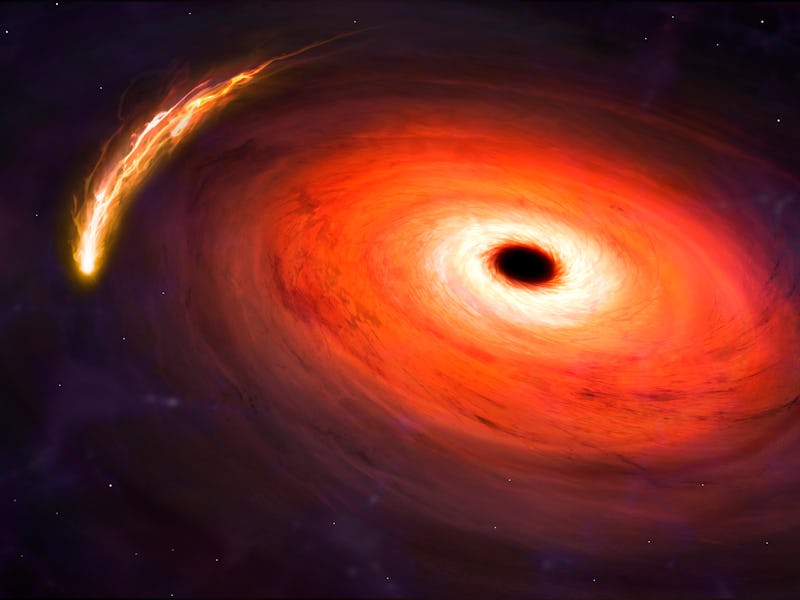X-Rays Kept Repeatedly Flashing Near a Supermassive Blackhole — Now Astronomers Think They Know What It Is
Om nom nom.

This doomed star keeps tripping over the shredded remains of its predecessor, and it’s kicking up flashes of x-rays.
At some point not very long ago in a galaxy relatively nearby, a star ventured too close to a black hole and got ripped apart by its tremendous tidal force. Another star, on its own death spiral toward the same fate, crossed the stream of blazing stellar debris and sparked cosmic fireworks in x-ray. The light show that unfolded is now offering physicists some important clues about general relativity and gravity.
“We could really test theories of the extreme gravity around supermassive black holes,” Queen's University Belfast astrophysicist Matt Nicholl tells Inverse.
Nicholl and his colleagues published their work in the journal Nature.
The black hole in this artist’s illustration is ripping apart a star, whose stretched-out gaseous remains will eventually fall onto the black hole.
This is Why You Look Before Crossing
Nicholl and his colleagues trained several telescopes on the center of a galaxy about 214 million light years away, where something around the supermassive black hole was erupting in bright bursts of x-rays every 48 hours. Astronomers had been watching this particular supermassive black hole since 2019, when it flared brightly with visible and ultraviolet light: an outburst that marked the violent death of a star. The explanation that best fits the data is that after the first star had been ripped apart and stretched into a spiral of glowing gas, along came another star, on its own death spiral toward the black hole. At the moment, that second star’s slowly shrinking orbit crosses the first star’s trail of electrically-charged gas about every 48 hours, sparking the bright x-ray flashes Nicholl and his colleagues saw.
“We think what happens is that the [orbiting star] punches out a cloud of gas from the disk, which is heated to something like a million degrees by the shock. As this shocked gas expands, it releases this energy in X-rays,” says Nicholl.
Astronomers had noticed that some supermassive black holes tended to flash x-rays repeatedly, but they weren’t sure why. Some thought that these repeated x-ray flashes, called “quasi-periodic eruptions,” were somehow related to a star getting torn apart in the black hole’s tremendous gravity.
But no one had seen all the pieces of the process happening in the same place, until this recent study.
Connecting the two phenomena could help physicists test some theories about how gravity works in the weird environment around a supermassive black hole, where spacetime is warped to the limits of what the theory of general relativity can describe.
Yet Another Test of General Relativity
When a star spirals toward a supermassive black hole, astronomers call it an “extreme mass-ratio inspiral,” which just means that the black hole tremendously outweighs the doomed star. By studying how the whole deadly, lopsided cosmic dance plays out, physicists could learn more about the weird ways in which gravity behaves near a supermassive black hole.
“EMRIs are an amazing probe of general relativity,” says Nicholl. “The huge asymmetry in mass means the orbit is much more complicated than the roughly equal-mass black hole mergers detected by current LIGO gravitational wave detectors.”
Sometime in the next few years, physicists will use the Laser Interferometer Space Antenna (LISA), a gravitational wave detector in space, to watch for the long, slow ripples in spacetime produced by the collisions of supermassive black holes. And because these extreme-mass-ratio inspirals could reveal so much useful information, measuring their gravitational waves is one of LISA’s biggest goals.
The challenge is that so far, physicists don’t know how common these inspirals actually are, which means it’s not clear whether they’ll happen often enough for LISA to stand a chance of catching one in action. But if Nicholl and his colleagues can find a few more quasi-periodic eruptions like the one in their recent study — and connect them to the violent, ripping deaths of stars around supermassive black holes — they’ll finally be able to answer that question.
“And there is a small chance that we could get lucky enough to detect an extreme-mass-ratio inspiral both in gravitational waves with LISA and in light if it produces a TDE or QPE source,” says Nicholl. “That would be the dream!”